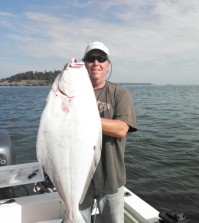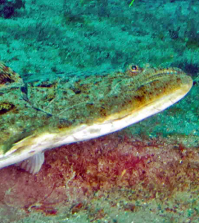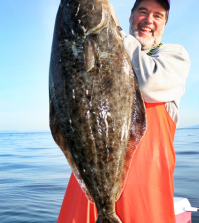What’s the Right Hook for Halibut?

One of the great myths of the Pacific halibut fishery—and there are many—is that the circle hook is the traditional halibut hook, and because of that, some anglers think it’s the only hook to use on the halibut grounds.
In fact, circle hooks are among the more recent additions to the Northwest halibut-fishing scene, first appearing in the Alaskan long-line fishery in the early 1980s after many years of proving its effectiveness in southern tuna fisheries. Bob Trumble, formerly of the International Pacific Halibut Commission, once told me that the change from J-hooks to circle hooks turned the commercial halibut fishery on its ear, causing such an increase in the long-line harvest in such a short time that scientists at first thought that halibut stocks had exploded. But no, there weren’t suddenly more halibut, just a phenomenal increase in the effectiveness of the long-line fishery when J-hooks were replaced with circle hooks. Once a halibut had a circle hook embedded where it belonged, there was little chance it was going to escape.
It didn’t take long for the word to get out, especially around the halibut capitals of Alaska, and soon recreational halibut fishermen were converting to the “can’t-miss” hooks that worked so well for the commercial boys.
The only problem is rod-and-reel fishing for halibut isn’t the same as long-lining for halibut. A baited circle hook attached to a long-line just lies there on the bottom and waits for a halibut to come along, inhale the bait, turn away and slowly tighten against the line until the hook nestles into position and the fish is on to stay. In sport fishing, though, the human factor comes into play when there’s a halibut biting at one end of the line and a real, live person waiting at the other end. Most of those folks are eager to hook that damn fish, and they don’t have the patience of an inanimate long-line.
So, at least part of the answer to the long-argued question of whether circle hooks or J-hooks are better for halibut fishing depends on the temperament of the angler. If you’re the patient type who can wait out a bite and basically let a halibut hook itself, you’re a circle hook fisherman. If you’re a rod-rippin’, hook-settin’ sumbitch, you’re most likely a J-hooker, and circle hooks are only going to frustrate you.
I’ve been described more than once as a type-A personality, which is another way of saying I use J-hooks, but I certainly understand the advantages of using circle hooks if you’re psychologically equipped to fish that way and the conditions allow or even call for it. Because of its design, with the inward-turned point nearly touching the inside of the shank, a circle hook isn’t likely to penetrate very many places in a halibut’s mouth except around a lip or, if allowed to be taken deep enough, to grab a corner of the gullet. Once it seats into one of those locations, it tends to stay put.
Since most circle-hooked halibut are lip-hooked, one great advantage to this system is that fish may be released quite easily and without much risk of injury. Being able to catch-and-release a number of smaller fish without causing serious injury to them while searching for that cooler-filler can be a good thing, especially if you’re on a northern charter boat drifting or anchored over the edge of an underwater hump that’s literally carpeted with 15- to 30-pound chicken halibut and you want to take home one of the bigger ones.
Remember, though, that those halibut-covered humps get more and more rare as you work your way south from the Bering Sea to the Strait of Juan de Fuca and farther down the coast toward the Oregon-California border, which means the likelihood of having to release a lot of small halibut greatly diminishes as we get into the waters where most of us happen to do most of our halibut fishing.
Partly because of the patience factor in using circle hooks, though, they’re best-suited to fishing in deeper water, and down here in the Lower 48 we certainly do a lot of our fishing in deep water. Many of our more productive fisheries in the Strait occur in 200 to 400 feet of water, and some of the coastal halibut fisheries off the Washington and Oregon coasts are over submerged plateaus and drop-offs ranging from 450 to 700 feet deep. Under those conditions, leaving a bait down there long enough for a halibut to take it and waddle off can be a little more palatable, even for a high-energy halibut angler.
Even though deep-water fishing may be more conducive to using circle hooks, the majority of halibut anglers down here in Oregon, Washington and much of British Columbia tend to favor J-hooks. In most of the places we fish, we’re happy with the first legal halibut we bring to the boat, so sorting and catch-and-release fishing aren’t all that common. Who cares if the fish is deeply hooked if we’re going to kill it and eat it anyway?
What’s more, a J-hook tends to stick and hold no matter what part of the mouth it slices into, unlike the circle hook. I think I’ve hooked at least one halibut in every possible square inch of the head from the gill cover to the tip of the snout, not to mention the tongue, roof of the mouth, gullet, upper and lower jaw and every other available spot on the inside of the mouth. It stuck wherever it happened to be pointed when I reared back on the rod. The bottom line is that anglers using J-hooks tend to enjoy a higher hook-up rate over a much wider range of fishing conditions, baits, techniques and various size halibut.
It’s also worth mentioning that those of us down here near the southern end of the Pacific halibut’s range will likely find it easier to find and buy J-hooks than circle hooks, and they’ll probably be at least a little cheaper. I can usually walk into one of my favorite tackle stores here in the Puget Sound region and find the style and size J-hook I need for my next halibut trip, while the circle-hook selection my be substantially more limited.
Which brings us to the topic of exactly what is the “right” size hook, whether it be J-style or circle? Over the years I’ve targeted halibut with everything from 5/0 J-hooks to 16/0 circle hooks, the variables determining that wide range being size of the bait I was using and, in most cases, the size of the halibut I hoped eventually to catch. One of the situations where I used the 5/0’s was to fish whole candlefish around the edges of Hein Bank in 125 to 200 feet of water. The 16/0 circle hook was partially concealed in a 10-inch length of wrist-thick octopus tentacle that I had carted from Olympia to somewhere in Alaska’s Cook Inlet. I remember at least some of the 15- to 25-pound halibut I caught with the 5/0’s and probably won’t ever forget the 111-pounder that eventually inhaled and rumbled off with that big circle hook firmly embedded in the corner of its mouth. Needless to say, matching the size and style hook to the size and kind of bait and the fishing situation was the key in both instances, as it usually is in selecting the right halibut hook.
I seldom target big halibut these days—partly to avoid being disappointed and partly because I prefer catching those hard-fighting and sweet-eating 40- to 70-pounders that are much more abundant in most of the places I fish—but when I was into barn-door halibut I used a lot of large baits of various kinds, and I always had more hook-ups and a higher percentage of fish landed when I used two J-hooks rather than a single hook of either style. My favorite big baits were whole fish and long strips cut from big fish, as opposed to what I call “chunk baits,” such as salmon heads or a thick piece of octopus wadded onto a hook. With whole fish or strips, I liked to fish a hook near each end, so I usually custom-tied my tandem-hook rigs to fit an individual bait; if the bait was 20 inches long I tied the hooks 16 to 18 inches apart, so I could fish it with a hook near the top and the bottom end. I typically used hooks in the 10/0 to 12/0 range for that kind of fishing.
In recent years I’ve done most of my halibut fishing with smaller baits and smaller hooks. Black label herring and other baitfish in the 9- to 11-inch range are pretty standard, and I also use quite a few salmon bellies ranging from 7 to 12 inches. Both baits can be fished with a pair of hooks tied 6 to 10 inches apart, downsized versions of the rigs I used with bigger baits in years past. These days, my hook preference for these rigs is a pair of Owner SSW Cutting Points in size 8/0 or 9/0.
When using herring and other baitfish, I sometimes fish a single hook rather than tandem hooks, running it up through the head near the tip of the snout twice and then pulling enough slack to seat the hook into the side of the bait just above the tail. When using a single hook I usually upsize to the 10/0 SSW Cutting Point, the largest available in that style.










